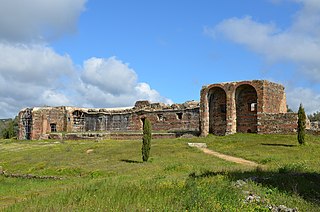Related Research Articles

Alandroal is a municipality in the Portuguese district of Évora located on the eastern frontier with Spain along the right margin of the Guadiana River in the Central Alentejo region. It is located 341 metres (1,119 ft) above sea level, northeast of Évora and southeast of Estremoz. The population in 2011 was 5,843, in an area of 542.68 km².

Reguengos de Monsaraz is a municipality in Évora District in Portugal. The population in 2011 was 10,828, in an area of 464.00 km². The City of Reguengos de Monsaraz proper has a population of 7,308.

Monsaraz is a civil parish (freguesia) of the municipality of Reguengos de Monsaraz, on the right margin of the Guadiana River in the Portuguese Alentejo region, near its border with Spain. The population in 2011 was 782, in an area of 88.29 km².

The Roman ruins of São Cucufate is a Romanesque archaeological site, located on the ruins of a Roman-era agricultural farm in the civil parish of Vila de Frades, in the municipality of Vidigueira, in the southern Alentejo, Portugal. The convent, which dates back to Middle Ages, was dedicated to the martyred saint Cucuphas.

The Castle of Evoramonte, alternately spelled Évora Monte or Évoramonte, is a Portuguese castle in the civil parish of Evoramonte, municipality of Estremoz in the former district of Évora. Initiated in 1160, in the Gothic period, it was enlarged in later centuries in the Manueline style. It was at this site that the Concession of Evoramonte on was signed on 26 May 1834, that ended Liberal Wars between the Liberal forces of Queen Maria II of Portugal and Absolutist armies of Miguel of Portugal. Since 1910, it has been listed as a Portuguese National monument.

The Castle of Terena is a castle in the civil parish of Terena in the municipality of Alandroal in the Portuguese subregion of Alentejo Central. Since 1946, it has been listed as a National monument.

The Castle of Alandroal is a medieval castle in the civil parish of Alandroal, São Brás dos Matos e Juromenha, municipality of Alandroal, Portuguese district of Évora, classified as a National Monument.

The Castle of Beja is a medieval castle in the civil parish of Beja, municipality of Beja, Portuguese district of Beja.

The Castle of Redondo is a medieval castle located in the civil parish of Redondo, in the municipality of Redondo, Portuguese Évora.

The Castle of Valongo is a well-preserved medieval castle located in the civil parish of Nossa Senhora de Machede, in the municipality of Évora, Portuguese Évora.
The Castle of Degebe is a medieval castle located in the civil parish of Reguengos de Monsaraz, in the municipality of Reguengos de Monsaraz, Portuguese district of Évora.

The Castle of Vidigueira is a castle in the civil parish of Vidigueira in the municipality of Vidigueira in the Portuguese subregion of Baixo Alentejo. Although constructed in the first half of the 15th century, it is more commonly associated with the first of the Counts of Vidigueira: Vasco da Gama.
The Church of the Lóios is a 15th church civil parish of Évora, municipality of Évora, in the Portuguese Alentejo.

The Palace of the Counts of Azambuja, alternately the Palace Valada-Azambuja is a 16th-century Portuguese estate manorhouse/palace situated in the civil parish of Misericórdia, municipality of Lisbon.
The Chapel of Nossa Senhora dos Mártires, is a hermitage in the civil parish of Estremoz, in the municipality of Estremoz, in the district of Èvora.
Francisco Caldeira CabralGCIH • GOIP was a Portuguese landscape architect. He was an active and internationally reputed landscape architect from the 1940s to the 1980s. He was a pioneer in the practice, study and teaching of Landscape Architecture, and he was a pioneer of the Portuguese environmental movement.

The Castle of Ródão is a medieval castle located in the civil parish of Vila Velha de Ródão, in the municipality of Vila Velha de Ródão, Portuguese Castelo Branco.

The Quinta da Ribafria is situated close to Sintra in Lisbon District, Portugal. It was built from 1536 to 1541 by Gaspar Gonçalves, a ceremonial official of the Portuguese Royal Household, on land donated to him by King Manuel I in 1515. The property is now owned by the Sintra Municipality.

The Good and the Bad Judge is a c. 15th-century fresco panel decorating the audience chamber of the old town hall of the municipality of Reguengos de Monsaraz, a medieval town situated in the south of Portugal, near the border with Spain. The distinctiveness of its iconography makes it a unique and rare artwork in the context of European Renaissance painting.
References
- Notes
- 1 2 3 4 5 6 7 8 9 10 11 12 Branco, Manuel; Nunes, Castro; Camara, Teresa (2005), SIPA (ed.), Castelo de Vidigueiras/Castelo da Vidigueira/Torre das Vidigueiras/Quinta das Vidigueiras (PT040711040007) (in Portuguese), Lisbon, Portugal: SIPA–Sistema de Informação para o Património Arquitectónico, archived from the original on 6 March 2016, retrieved 27 December 2012
- Sources
- Gonçalves, José Pires (1962), "Monsaraz e o seu termo", Boletim da Junta Distrital de Évora (in Portuguese)
- Espanca, Túlio (1978), "Distrito de Évora, Concelho de Reguengos de Monsaraz", Inventário Artístico de Portugal (in Portuguese), VIII, SNBA
- Andresen, Teresa (2003), Do Estádio Nacional ao Jardim Gulbenkian, Francisco Caldeira Cabral e a Primeira Geração de Arquitectos Paisagistas (1940-1970) (in Portuguese), Lisbon, Portugal
- Andresen, Teresa (2001), Francisco Caldeira Cabral, England, United Kingdom




